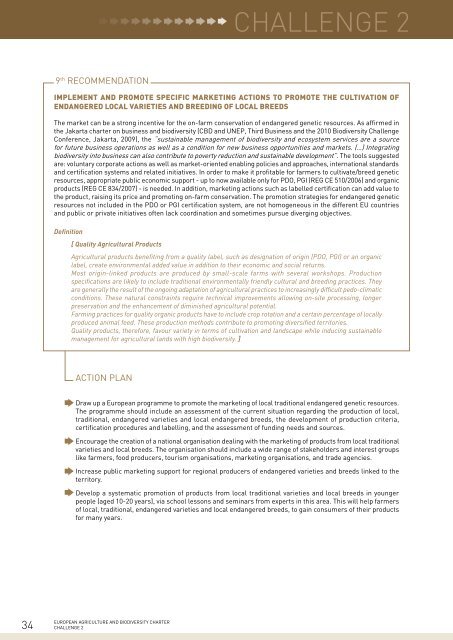agriculture - Reverse, European Project to Preserve Biodiversity
agriculture - Reverse, European Project to Preserve Biodiversity
agriculture - Reverse, European Project to Preserve Biodiversity
Create successful ePaper yourself
Turn your PDF publications into a flip-book with our unique Google optimized e-Paper software.
34<br />
9 th RECOMMENDATION<br />
CHALLENGE 2<br />
IMPLEMENT AND PROMOTE SPECIFIC MARKETING ACTIONS TO PROMOTE THE CULTIVATION OF<br />
ENDANGERED LOCAL VARIETIES AND BREEDING OF LOCAL BREEDS<br />
The market can be a strong incentive for the on-farm conservation of endangered genetic resources. As affirmed in<br />
the Jakarta charter on business and biodiversity (CBD and UNEP, Third Business and the 2010 <strong>Biodiversity</strong> Challenge<br />
Conference, Jakarta, 2009), the “sustainable management of biodiversity and ecosystem services are a source<br />
for future business operations as well as a condition for new business opportunities and markets. (…) Integrating<br />
biodiversity in<strong>to</strong> business can also contribute <strong>to</strong> poverty reduction and sustainable development”. The <strong>to</strong>ols suggested<br />
are: voluntary corporate actions as well as market-oriented enabling policies and approaches, international standards<br />
and certification systems and related initiatives. In order <strong>to</strong> make it profitable for farmers <strong>to</strong> cultivate/breed genetic<br />
resources, appropriate public economic support - up <strong>to</strong> now available only for PDO, PGI (REG CE 510/2006) and organic<br />
products (REG CE 834/2007) - is needed. In addition, marketing actions such as labelled certification can add value <strong>to</strong><br />
the product, raising its price and promoting on-farm conservation. The promotion strategies for endangered genetic<br />
resources not included in the PDO or PGI certification system, are not homogeneous in the different EU countries<br />
and public or private initiatives often lack coordination and sometimes pursue diverging objectives.<br />
Definition<br />
[ Quality Agricultural Products<br />
Agricultural products benefiting from a quality label, such as designation of origin (PDO, PGI) or an organic<br />
label, create environmental added value in addition <strong>to</strong> their economic and social returns.<br />
Most origin-linked products are produced by small-scale farms with several workshops. Production<br />
specifications are likely <strong>to</strong> include traditional environmentally friendly cultural and breeding practices. They<br />
are generally the result of the ongoing adaptation of agricultural practices <strong>to</strong> increasingly difficult pedo-climatic<br />
conditions. These natural constraints require technical improvements allowing on-site processing, longer<br />
preservation and the enhancement of diminished agricultural potential.<br />
Farming practices for quality organic products have <strong>to</strong> include crop rotation and a certain percentage of locally<br />
produced animal feed. These production methods contribute <strong>to</strong> promoting diversified terri<strong>to</strong>ries.<br />
Quality products, therefore, favour variety in terms of cultivation and landscape while inducing sustainable<br />
management for agricultural lands with high biodiversity. ]<br />
ACTION PLAN<br />
Draw up a <strong>European</strong> programme <strong>to</strong> promote the marketing of local traditional endangered genetic resources.<br />
The programme should include an assessment of the current situation regarding the production of local,<br />
traditional, endangered varieties and local endangered breeds, the development of production criteria,<br />
certification procedures and labelling, and the assessment of funding needs and sources.<br />
Encourage the creation of a national organisation dealing with the marketing of products from local traditional<br />
varieties and local breeds. The organisation should include a wide range of stakeholders and interest groups<br />
like farmers, food producers, <strong>to</strong>urism organisations, marketing organisations, and trade agencies.<br />
Increase public marketing support for regional producers of endangered varieties and breeds linked <strong>to</strong> the<br />
terri<strong>to</strong>ry.<br />
Develop a systematic promotion of products from local traditional varieties and local breeds in younger<br />
people (aged 10-20 years), via school lessons and seminars from experts in this area. This will help farmers<br />
of local, traditional, endangered varieties and local endangered breeds, <strong>to</strong> gain consumers of their products<br />
for many years.<br />
EUROPEAN AGRICULTURE AND BIODIVERSITY CHARTER<br />
CHALLENGE 2



